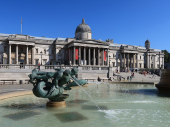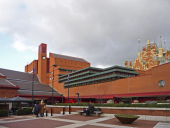
Culture
-
 Earliest evidence of human fire-making unearthed in Suffolk
A team led by the British Museum has uncovered what is now the earliest known evidence of humans deliberately making fire—dating back around 400,000 years—at a site in Barnham,Read More...
Earliest evidence of human fire-making unearthed in Suffolk
A team led by the British Museum has uncovered what is now the earliest known evidence of humans deliberately making fire—dating back around 400,000 years—at a site in Barnham,Read More... -
 Rothschild 15th-century prayer book set to fetch up to $7 million at Sotheby’s auction
Ultra-rare 15th-century mahzor features vivid medieval illustrationsRead More...
Rothschild 15th-century prayer book set to fetch up to $7 million at Sotheby’s auction
Ultra-rare 15th-century mahzor features vivid medieval illustrationsRead More... -
 Ray Winstone honoured with Freedom of the City of London
Ray Winstone, one of the UK’s most celebrated ‘hard man’ actors, has been awarded the Freedom of the City of London in recognition of his extensive charitable and fundraising work.Read More...
Ray Winstone honoured with Freedom of the City of London
Ray Winstone, one of the UK’s most celebrated ‘hard man’ actors, has been awarded the Freedom of the City of London in recognition of his extensive charitable and fundraising work.Read More... -
 Golden Globe 2026 nominations announced ahead of January ceremony
The nominations for the 83rd annual Golden Globe Awards were unveiled on Monday, setting the stage for the first major awards ceremony of the season on January 11.Read More...
Golden Globe 2026 nominations announced ahead of January ceremony
The nominations for the 83rd annual Golden Globe Awards were unveiled on Monday, setting the stage for the first major awards ceremony of the season on January 11.Read More... -
 Mayor of London granted right to use historic GLC coat of arms
The Mayor of London has been officially granted permission to use the historic coat of arms once belonging to the former Greater London Council (GLC), following approval from the King.Read More...
Mayor of London granted right to use historic GLC coat of arms
The Mayor of London has been officially granted permission to use the historic coat of arms once belonging to the former Greater London Council (GLC), following approval from the King.Read More... -
 Who will shape the National Gallery’s tomorrow? Architects shortlisted for landmark expansion
The National Gallery has announced a shortlist of six architectural teams competing to design a major new wing as part of its ambitious £750 million Project DomaniRead More...
Who will shape the National Gallery’s tomorrow? Architects shortlisted for landmark expansion
The National Gallery has announced a shortlist of six architectural teams competing to design a major new wing as part of its ambitious £750 million Project DomaniRead More... -
 National Gallery unveils ambitious exhibition programme for 2026
The National Gallery has announced a landmark line-up of exhibitions for 2026, spanning five centuries of European art and bringing together rare loans, first-ever UK presentations, and iconicRead More...
National Gallery unveils ambitious exhibition programme for 2026
The National Gallery has announced a landmark line-up of exhibitions for 2026, spanning five centuries of European art and bringing together rare loans, first-ever UK presentations, and iconicRead More... -
 OUP India launches 100 libraries for underprivileged children across Uttar Pradesh
Oxford University Press (OUP) India has partnered with the National Book Trust (NBT) to establish 100 libraries for underprivileged children across Anganwadi centres inRead More...
OUP India launches 100 libraries for underprivileged children across Uttar Pradesh
Oxford University Press (OUP) India has partnered with the National Book Trust (NBT) to establish 100 libraries for underprivileged children across Anganwadi centres inRead More... -
 Children’s author Iryna Kotlyarevska: “Stories born from family evenings”
Iryna Kotlyarevska is a name increasingly found on the shelves of family libraries. A mother of four, a Bachelor of Philosophy, a Master of Political Science, and the creator of the worlds ofRead More...
Children’s author Iryna Kotlyarevska: “Stories born from family evenings”
Iryna Kotlyarevska is a name increasingly found on the shelves of family libraries. A mother of four, a Bachelor of Philosophy, a Master of Political Science, and the creator of the worlds ofRead More... -
 Ashmolean Museum passes one million visitors for first time since 2008
The Ashmolean Museum in Oxford has recorded more than one million visitors in a single year, the first time it has reached the milestone in 16 years, the institutionRead More...
Ashmolean Museum passes one million visitors for first time since 2008
The Ashmolean Museum in Oxford has recorded more than one million visitors in a single year, the first time it has reached the milestone in 16 years, the institutionRead More... -
 Writer’s Award 2026 honours Jacqueline Crooks and Vanessa Londoño
Jacqueline Crooks and Vanessa Londoño have been named the 2026 recipients of the Eccles Institute and Hay Festival Global Writer’s Award. The announcement was made Monday evening atRead More...
Writer’s Award 2026 honours Jacqueline Crooks and Vanessa Londoño
Jacqueline Crooks and Vanessa Londoño have been named the 2026 recipients of the Eccles Institute and Hay Festival Global Writer’s Award. The announcement was made Monday evening atRead More... -
 At Britain’s first plant-based Michelin-Star restaurant, most diners aren’t vegan
At Plates, the first fully plant-based restaurant in Britain to earn a Michelin star, the dining room is full most nights — yet the vast majority of guests aren’t vegan.Read More...
At Britain’s first plant-based Michelin-Star restaurant, most diners aren’t vegan
At Plates, the first fully plant-based restaurant in Britain to earn a Michelin star, the dining room is full most nights — yet the vast majority of guests aren’t vegan.Read More...

British Queen celebrates
Most Read
- Teen held after US woman killed in London stabbings
- Heave-ho Harry! Prince prepares to join the walking wounded in ice trek to North Pole
- Football: Farhad Moshiri adamant Everton deal above board
- "Master of English Style". Interview with Designer Lydia Dart
- Letter to the Financial Times from Lord Mayor Alderman Michael Bear
UK news

Heathrow Airport is currently dealing with a strike by security guards who are members of the Unite union. Talks broke down on Wednesday over a pay dispute, leading to the first in a series of

Oil giant Shell announced a profit of £7.6 billion ($10.4 billion) for Q1 2023, representing a 5.7% increase on the previous year and nearly £1.4 billion ($1.9 billion) more than experts had

The Society of Motor Manufacturers and Traders (SMMT) has reported that British new car registrations have increased by over 10% in April 2023, marking the ninth consecutive monthly rise

On Wednesday, the Lotto winning numbers were 12, 28, 33, 37, 42, 49, with the bonus number 25. However, no player claimed the top prize, leading to Saturday's National Lottery Jackpot

According to a new price comparison tool released by the UK's statistics office on Wednesday, cucumbers, olive oil, and cheese topped Britain's inflation chart in March. The price of a cucumber

The Conservatives are preparing for a challenging week in the upcoming local elections, with some analysts predicting that the party could lose as many as 1,000 council seats. Prime Minister

In what is being touted as the largest security operation in British history, a record 11,500 police officers will be deployed to guard the Coronation of King Charles this weekend in London.

More than 7 million households across the UK will have been paid a £301 Cost of Living Payment by the end of today (3 May 2023).

People living and working in the Lockerbie area in Scotland are to benefit from significantly improved mobile phone connectivity as the first UK government-funded rural

On Sunday, RAF jets intercepted a Russian reconnaissance aircraft, the Tupolev Tu-142, that was flying near Scottish airspace. The aircraft was spotted over the seas north of Scotland and at





















